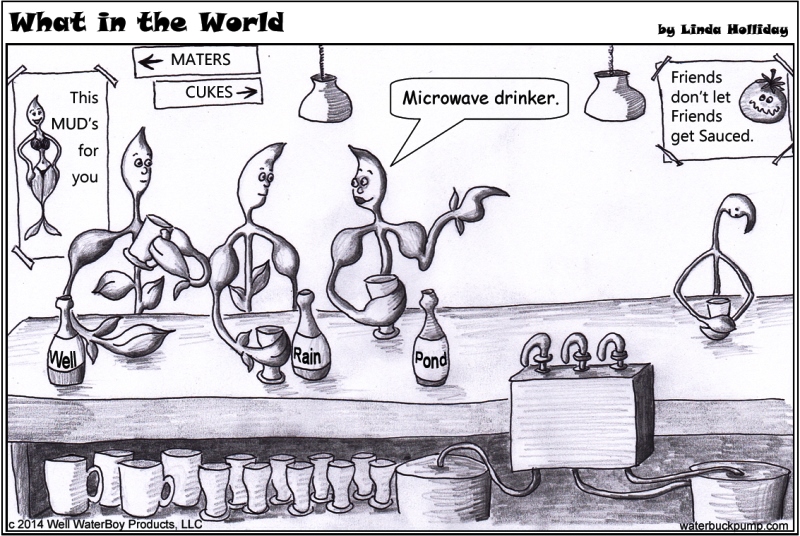After seeing conflicting accounts of whether microwaved food retains nutrients, I decided to try a semi-scientific experiment here with tomato plants and five water sources. The results, so far, have surprised me.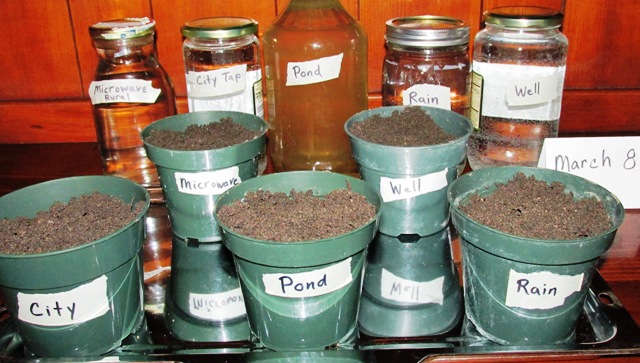
I understand my test does not meet scientific standards. This project was simply to satisfy my curiosity about water and its effect on living things. After reading “The Secret Life of Plants,” I am even more convinced that we are not so different than vegetation rooted in the ground.
On March 7 I filled five glass jars with unfiltered water from our well, our rain barrel, tap water from a nearby town, a cattle pond and our well water microwaved for 4 minutes. Because some of the water was icy (the pond water even had ice chunks in it), I put all the bottles in the living room to reach the same temperature overnight.
Since I do not have a microwave, I brought a bottle of our well water to our local library to microwave, not to the boiling point. (Funny, but our librarian didn’t even question my odd request.)
About a month before starting this experiment, we tested our well water for nitrates, lead, pesticides, etc. No contaminants were found.
On March 8 I filled five pots with an equal amount of potting soil taken from the same bag. This is not something I normally buy, but wanted to ensure the soil was as identical as soil can be. My normal seed-starting mixture of our compost and garden soil would’ve been too variable for this experiment.
Meanwhile, I soaked 20 heirloom Golden Jubilee tomato seeds in our well water for about 2 hours before planting 4 seeds each in the pots. By the way, this is an absolutely delicious variety of tomatoes with large, golden fruit.
If I were to conduct this test again, I’d have soaked the seeds in their respective water sources. I realize now how important that first taste of water is to seeds. I’m already considering a test with bean seeds, which I think will show more dramatic results in less time.
Next, I watered each pot with an equal amount of water and kept the pots together on a tray, giving them the same temperature, light and amount of water throughout the test.
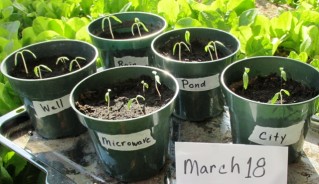 On March 11, the seeds began sprouting. There was no noticeable difference in any of the pots.
On March 11, the seeds began sprouting. There was no noticeable difference in any of the pots.
By March 18, differences were becoming apparent. The seedlings in the microwaved water barely changed since sprouting, while all the others were gaining in height and stoutness. Even the city tap water was keeping pace with the three leaders. I noticed that although the microwaved water pot had the smallest seedlings and received the same amount of water as the other pots, its soil always dries out sooner. It’s as if the seedlings are starving for water or nutrition. The seedlings also are slightly yellow compared to those in the other four pots.
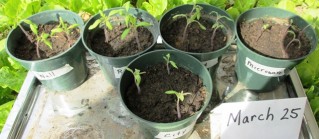 By March 20, the seedlings in the well, pond and rainwater pots were large enough to transplant to larger pots, but I had to wait 10 more days for the city and microwaved pots to get their first set of leaves. The well water is tallest, with the pond and rainwater next and identical in appearance, followed by the city tap and microwaved water.
By March 20, the seedlings in the well, pond and rainwater pots were large enough to transplant to larger pots, but I had to wait 10 more days for the city and microwaved pots to get their first set of leaves. The well water is tallest, with the pond and rainwater next and identical in appearance, followed by the city tap and microwaved water.
On March 31, I selected the largest seedling from each pot to transplant into a larger pot. Again, I used identical pots and amounts of soil. They seedling heights ranged from well water at 3 1/2”, rainwater 3”, pond 3”, city tap 2 1/2” and microwave 2”. Besides the height difference, the best well, rain and pond-watered plants are more vigorous, bushy and green. The city tap water plant is starting to lag noticeably behind the three leaders.
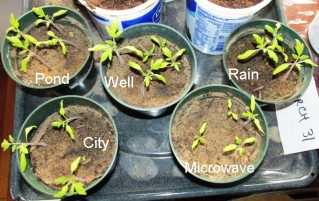 By April 4, the growth difference between the five pots is obvious. I intend to keep the test going until harvest time when the tomatoes will face the ultimate test – taste. I admit I am not eager to try the microwave-watered tomato. For the sake of science, however, I will.
By April 4, the growth difference between the five pots is obvious. I intend to keep the test going until harvest time when the tomatoes will face the ultimate test – taste. I admit I am not eager to try the microwave-watered tomato. For the sake of science, however, I will.
So far, the vigor of the well-watered plant quickly emerging as the leader surprised me, which is actually good news for us, in a way. It is troubling, though, that the pond and rainwater are not doing as well as I predicted. I thought murky pond water that smells like frogs, leaves and cattle would be healthiest. I also predicted rainwater would be in a close second. While both are in good condition, they are not the leaders I predicted.
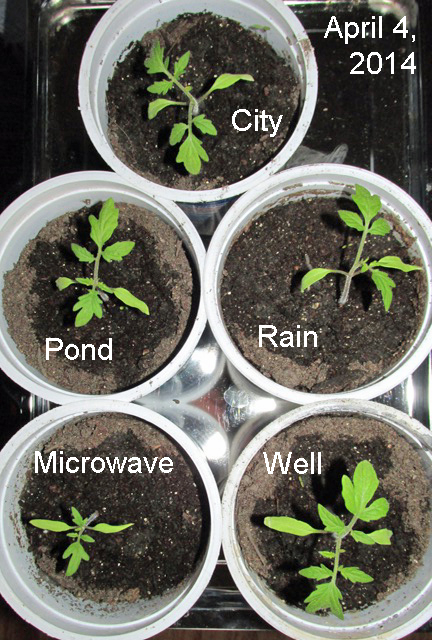 I am merely speculating here, but perhaps there are too many toxins now in our environment. Is runoff or acid rain affecting these water sources? Maybe because the well water goes through a natural filtration process before it reaches the plants it is better for them. These are things I hadn’t considered before this test.
I am merely speculating here, but perhaps there are too many toxins now in our environment. Is runoff or acid rain affecting these water sources? Maybe because the well water goes through a natural filtration process before it reaches the plants it is better for them. These are things I hadn’t considered before this test.
But, as I said, this is by no means “scientific,” just my homespun attempt at seeing how plants react to water that has been microwaved. Stay tuned for updates as the season progresses.
Also, if anyone has any recommendations for better testing methods, please let me know. I am always eager to learn all I can about our natural world, especially plants.
UPDATE 4/6/2014: On my next test I will microwave all of the waters to compare them to water that hasn’t been microwaved. This time I’ll use beans, which sprout and grow much more quickly. I also will soak the beans in their respective water sources before planting. Stay tuned.
©2014 Well WaterBoy Products LLC ♦ WaterBuck Pump™ ♦ Pedal Powered PTO™ 
